OSAMA BIN LADEN AFTER SEPTEMBER 11TH
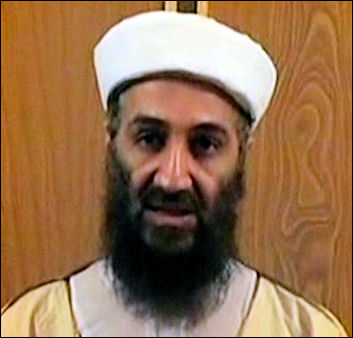
Osama bin Laden began acting like a prophet after the attack on the World Trade Center in New York on September 11, 2001 according to Al-Qaida members that were captured and interrogated. He began avoiding contact with rank-and-file members and began speaking through senior Al-Qaida leaders. One Moroccan told the Washington Post that one Saudi Al-Qaida member said that Osama bin Laden had a dream in which he saw America in ashes. It was like announcing a prophecy.”
In the view of some Osama bin Laden became a figurehead rather than a hands on leader after September 11th. It is widely believed that bin Laden gave up the day to day operations of Al-Qaida to others and basically hide away, releasing audio or video tapes from time to time, and occasionally issuing orders.
Ahmed Rashid, the respected author of “The Taliban,” wrote in the Washington Post: “It was in eastern Afghanistan that bin Laden made his last public appearance in Jalalabad on Nov. 10, 2001, just after the northern cities had begun to fall to the anti-Taliban alliance. He addressed an estimated 1,000 Pashtun notables and militants, urging them to continue resisting the American invaders, according to U.S. journalists working in the region at the time. He dished out wads of U.S. and Pakistani cash and then disappeared into the mountain fastness of Tora Bora, never to be seen again. (The CIA didn't learn of the meeting for several days.) [Source: Ahmed Rashid, Washington Post, March 1, 2006]
Kate Zernike and Michael T. Kaufman wrote in the New York Times: “After the attacks of Sept. 11, Bin Laden did what had become routine: He took to Arab television. He appeared, in his statement to the world, to be at the top of his powers. President Bush had declared that the nations of the world were either with the Americans or against them on terrorism; Bin Laden held up a mirror image, declaring the world divided between infidels and believers.” [Source: Kate Zernike and Michael T. Kaufman, New York Times, May 2, 2011]
“Bin Laden’s voice continued to be heard, off and on, for almost the next 10 years as he issued threats, warnings and pronouncements on video and audiotape from wherever he was hiding. As recently as October he appealed for aid for flood victims in Pakistan and blamed the West for causing climate change. His greatest hope, he told supporters, was that if he died at the hands of the Americans, the Muslim world would rise up and defeat the nation that had killed him.”
Omar Farooqi, a Taliban liaison officer with Al Qaeda, told Newsweek that Bin Laden had long been chafing over a gag order imposed on him for security reasons and became "extremely upset" in 2007 when he discovered that some of his lieutenants feared he was dead. Bin Laden has always loved talking to the media and, according to Farooqi, bin Laden had only reluctantly gone along with the advice that his safety required absolute silence. [Source: Newsweek, September 28, 2007]
Osama bin Laden’s Health After 9/11
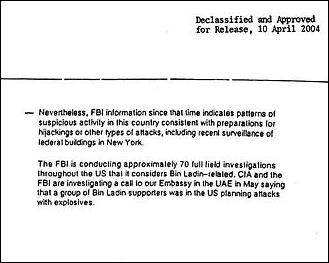
CIA Memo After September 11th there were occasional rumors about bin Laden suffering from poor health or even that he died. Some reported him riding on horseback. Others said he was ill with kidney disease. There were reports that he had dialysis treatment, even a kidney transplant. There was one rumor that bin Laden received kidney dialysis treatment in Pakistan on the eve of the September 11th attack. A medical worker told CBS news bin Laden was secretly brought to a hospital in Rawalpindi: “on that night they moved out all regular staffers in the urology department and sent in a secret team.”
A Pakistani doctor who claimed to have treated Osama bin Laden before and after the September 11th attacks said that bin Laden was in excellent health and said there were no signs of kidney disease. The doctor said he treated bin Laden in 1999 for a back injury he suffered after falling off his horse. He checked him out again a few weeks after the September 11th attacks and said both times his general health was good.
Jane Mayer wrote in The New Yorker, In the spring of 2002, “bin Laden reportedly sent a handwritten letter to his mother that said, “I am in good health and in a very, very safe place. They will not get me unless Allah wills it.” Another letter apparently from bin Laden, written in longhand [in early 2003] was found on the body of a suspected Al Qaeda operative who was killed by Saudi police in May. According to Al Watan, an Arabic daily, the letter offered season’s greetings on the occasion of Eid al-Fitr, a major Muslim holiday, and noted the “achievements of the Al Qaeda cells.” (A bloodstain obliterated the name of the letter’s recipient.)[Source: Jane Mayer, The New Yorker July 28, 2003]
Videos and Audio Tapes Released by Osama bin Laden
For years, the world only saw Osama bin Laden in the rare propaganda videos that trickled out. In these bin Laden often came off as calm, dignified and determined religious figure unfazed by being the target of worldwide manhunt. For the most part the video and audio tapes attributed to him were first broadcast on the Arabic-language television stations Al-Jazeera or Al-Arabiya, and were considered big enough news that were show on television news shows all over the world. The CIA did voice analysis to determine if the tapes were genuine (in most cases they were) and were dated mostly by events mentioned by bin Laden in the tapes. In some cases geologists were asked for their analysis of rocks in the background to try and determine where the tapes were made.
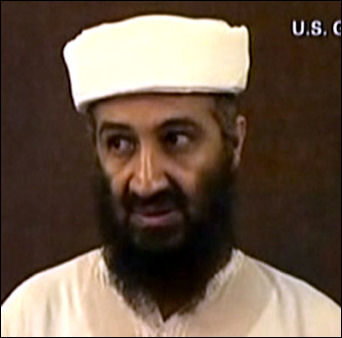
More than two dozen video or audio recordings purporting to be from Osama bin Laden were released after the September 11, 2001 attack on the World Trade Center. The Times said they were “repeated reminders that he, the al-Qaeda network and their brand of Islamist violence remain at large.” In the first of tapes, released three months after the destruction of the World Trade Centre, bin Laden appeared to take responsibility for (and pride in) that atrocity. One released in the late 2000s claimed the 2008-2009 global financial crisis had exposed the fragility and waning influence of the United States. The tapes continued to come even after bin Laden was killed. In one released in May 2011 after he was killed bin Laden praised the Arab Spring revolutions and called for more “tyrants” to be toppled.
On these tapes bin Laden weighed in everything from global warming to France's ban on burqas. Sometimes he issued threats. Often he commented on a wide range of current events. AP reported: “After a long silence, bin Laden stepped up his messages in 2006, and the subjects he addressed became more political. In January 2006, he addressed his comments to the American people rather than US President George W. Bush because, he said, polls showed "an overwhelming majority" of Americans wanted a withdrawal from Iraq. He even recommended Americans pick up a copy of the book The Rogue State, which he said offered a path to peace.” [Source: Paul Haven, AP, May 2, 2011]
Newsweek reported in 2007: “The intelligence community is reaching out to anyone who can glean even a hint of bin Laden's whereabouts. As early as November 2001, John Shroder, a geographer at the University of Nebraska, found himself addressing an audience of intelligence officials, analyzing the rock formations behind bin Laden in a video released that October. About all he could do was tell the spooks that bin Laden seemed to be in the western part of Afghanistan's Spin Ghar Mountains. "We were grasping at straws," says Michael Scheuer, who was special adviser to the head of the CIA's bin Laden unit at the time. "We called in geologists. We had the Germans bring in ornithologists because they thought they heard a bird chirping on a video and wanted to see if it was particular to certain regions of South Asia." [Source: Newsweek, Reported by Ron Moreau and Sami Yousafzai on the Afghanistan-Pakistan border; Zahid Hussain in Islamabad; Rod Nordland in Tora Bora; Mark Hosenball, Michael Hirsh, Michael Isikoff, John Barry, Dan Ephron and Eve Conant in Washington; Christopher Dickey in Paris, and Roya Wolverson in New York. Written by Evan Thomas. September 3, 2007]
Revelations from Documents and Materials Seized from Osama bin Laden’s Compound
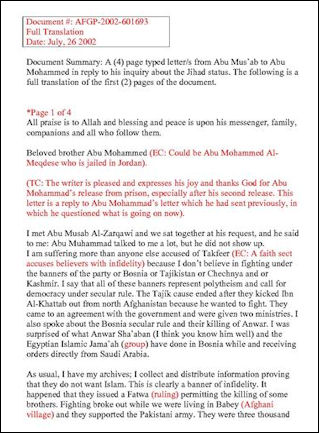
Translation of Status of Jihad Eugene Robinson wrote in the Washington Post: From the computer files and handwritten journals that Navy SEALs managed to scoop up in the raid...it appears that some of al-Qaida’s younger, more vigorous and more practical leaders chafed at bin Laden’s direction. They believed, logically, that it was a waste of time and effort to try to equal or top the Sept. 11, 2001, attacks while there were much softer targets closer to home. [Source: Eugene Robinson, Washington Post , on May 12, 2011]
“What’s interesting, though, is that while affiliates such as the Yemen-based al-Qaida in the Arabian Peninsula might not have welcomed all of bin Laden’s advice, they still paid attention. Even in his isolation, able to communicate only by courier, bin Laden remained the inspirational leader of the jihadist movement.”
Greg Miller and Peter Finn wrote in the Washington Post : Osama bin Laden spent his final years struggling to exert authority over the al-Qaeda network he founded, voicing dismay about the decisions of regional affiliates and drafting orders for often unresponsive subordinates even just one week before he was killed, according to documents released. The letters, part of a trove of material recovered during the U.S. raid on bin Laden’s compound, include chilling admonitions to remain focused on killing Americans. They also cast doubt on suspicions that the governments of Pakistan and Iran collaborated with the terrorist group. [Source: Greg Miller and Peter Finn, Washington Post , May 3, 2012]
In letters from his last hideout, Osama bin Laden fretted about dysfunction in his terrorist network and the loss of trust from Muslims he wished to incite against their government and the West. The documents, declassified by the Obama administration, represent only a small fraction of the material recovered in the bin Laden raid, a sample that seems aimed at exposing the discord between al-Qaeda’s core and the franchises that are now considered more worrisome national security threats.
But the files also provide an intriguing glimpse into the aging al-Qaeda leader’s thoughts as his life neared its end. He expressed concern that the group’s brand had been tarnished by attacks against Muslims, and that the group had become distracted by regional fights. “Our strength is limited,” bin Laden wrote in a 2010 letter that compared the United States to a tree with branches that project across the world. “So our best way to cut the tree is to concentrate on sawing the trunk.” The details are embedded in a collection of 17 files that span 175 pages and were made available online by the Combating Terrorism Center at the U.S. Military Academy at West Point. The files cover a span from 2006 to the week before bin Laden’s death.
The files reveal a widening gap between bin Laden and his longtime deputy, Ayman al-Zawahiri. Instead, bin Laden appears to have become increasingly close to another subordinate, Atiyah abd-al Rahman, who was the frequent recipient of missives that make the al-Qaeda leader seem out of touch with how depleted his organization had become. “It would be nice,” bin Laden wrote repeatedly in a 48-page letter to Rahman that contains daunting requests. Among them are to move followers out of the reach of CIA drones, fix the network’s followers and train new recruits on aircraft. It also instructs Rahman to locate a “brother distinguished by his good manners, integrity, courage, and secretiveness, who can operate in the US.”
Osama bin Laden’s “Like a Crime Boss”

Translation of Thoughts About
Security of Principal Squads Greg Miller and Karen DeYoung wrote in the Washington Post: Even while sealed inside a cement compound in a Pakistani city, bin Laden functioned like a crime boss pulling strings from a prison cell, sending regular messages to his most trusted lieutenants and strategic advice to far-flung franchises, including al-Qaeda’s affiliate in Yemen. Some followers pledged their fealty to him; others, however, chafed at his exhortations to remain focused on U.S. targets instead of mounting less risky operations in places such as Yemen, Somalia and Algeria. [Source: Greg Miller and Karen DeYoung, Washington Post, May 12, 2011]
“U.S. officials said bin Laden had a relatively short list of senior al-Qaeda members whom he was in touch with frequently and directly, albeit through messages smuggled out of the compound by couriers. Among them were Ayman al-Zawahiri, the Egyptian physician who had long functioned as bin Laden’s second in command, as well as Atiyah Abd al-Rahman, a Libyan operative who is the latest to fill the organization’s vulnerable No. 3 slot.
“Bin Laden’s directions tended to be big-picture in nature, officials said, focusing more on broader objectives than on granular operational details. “I wouldn’t call it command and control” that bin Laden was exercising, the senior U.S. intelligence official said. Indeed, there is no indication that bin Laden even knew the specific whereabouts of Zawahiri and others. Al-Qaeda’s fragmented nature and operational security appear to have kept its leader substantially in the dark.
“We’re not going to find operational manuals or Excel spreadsheets” with rosters of operatives and points of contact, the senior intelligence official said. Bin Laden served as a “chief executive who is giving fairly generic, broad instructions and guidance rather than tactical orders,” the official said. The U.S. intelligence official said bin Laden’s records have “confirmed our view that AQAP is first among equals in terms of relationships with al-Qaeda core.” The acronym refers to al-Qaeda in the Arabian Peninsula, the Yemen-based group that has been behind a series of plots targeting the United States, including the attempted bombing of a Detroit-bound airliner on Christmas Day 2009.
A second U.S. official familiar with the data review said that, based on the records, bin Laden also seemed to have placed a low priority on operations inside Afghanistan and Pakistan, urging his network to focus on efforts that will “make America weak, using Latinos and African Americans, people who are oppressed in the United States.” “Bin Laden is saying, “You’ve got to focus on the U.S. and the West,” said a senior U.S. intelligence official who was involved in reviewing the stockpile, adding that some of bin Laden’s followers seemed more concerned with regional issues and were reluctant to conduct an attack that would provoke an American response.
Osama bin Laden’s Concerns in His Final Days
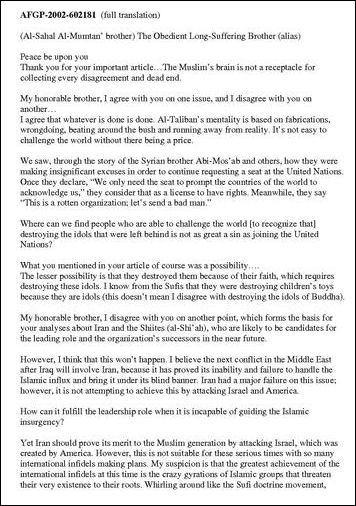
Translation of the Political Speculation Reuters reported: “Osama bin Laden showed disdain for al Qaeda affiliates, fretted about his organization's image and was deeply worried about its security, according to documents seized from his hideout in Pakistan and released publicly by the Combating Terrorism Center, a privately funded research center at the U.S. Military Academy at West Point (http:www.ctc.usma.edu). Several of the documents contain signoffs that U.S. experts assessed to have been used by bin Laden himself, including variations of the names "Zamarai" and "Abu 'Abdallah." Bin Laden wrote about sending messages via thumb drives or telephone memory cards - the same Arabic word is used for both. [Source: Tabassum Zakaria and Mark Hosenball, Reuters, May 3, 2012]
Bin Laden "was not, as many thought, the puppet master pulling the strings that set in motion jihadi groups around the world," an analysis by the center said. Bin Laden "was burdened by what he saw as their incompetence." The al Qaeda leader worried about operational security, advising against meeting on roads and then traveling in cars. Bin Laden expressed concern about Muslims being killed in al Qaeda operations and wanted women and children kept away from danger.
"Bin Laden was bothered by the incompetence of al Qaeda's affiliates, such as their failure to win public support, their ill-advised media campaigns, and their poorly planned operations that led to the unnecessary deaths of thousands of Muslims," said Lieutenant Colonel Liam Collins, director of the Combating Terrorism Center and one of the report's authors. "Perhaps the most compelling revelation from the documents is that bin Laden was frustrated with regional jihadi groups," he told Reuters. "He appeared to struggle to exercise control over the actions of the affiliates, as well as their public statements."
The week before he was killed bin Laden offered instructions on how to handle French hostages held by "brothers in the Islamic Maghreb." If the hostages had to be killed, it should be done after events in Libya, but he suggested it would be better to exchange a female hostage, and at a minimum keep the most important male hostage until French elections. He wrote that a British officer captured by "our brothers in Somalia" should be traded for "our prisoners."
Bin Laden also worried that children of militants who lived in cities were "one of the most important security issues" and advocated keeping control of them by not taking them out of their homes except for medical care. Parents were also urged to teach their children the local language so they would blend in. He also worried about the safety of one of his sons: "Regarding my son Hamzah and his mother, I wish you take all the security precautions that were mentioned before in order to disrupt surveillance on him. He should move only when the clouds are heavy."
Rebranding Al-Qaida

Translation of the Political Speculation page 2 AFP reported: “Osama bin Laden was so worried that killing Muslims had tainted al-Qaeda’s image that he proposed rebranding the group with a different name. What bothered bin Laden, he wrote, was that “al-Qaeda describes a military base with fighters without a broader mission to unify the nation.” In a letter found at his Pakistani compound, the late Al-Qaeda mastermind contemplated new names for his terror network that he hoped would better reflect his vision of a holy war with the West, the official, who spoke on condition of anonymity, told AFP. "It was sort of like brand-imaging," the official said. [Source: AFP, June 24, 2011]
Bin Laden's proposals for alternative names were not exactly dynamic. He suggested possibly Taifat al-Tawhed Wal-Jihad, or Monotheism and Jihad Group, and Jama'at I'Adat al-Khilafat al-Rashida, translated as Restoration of the Caliphate Group, the official said.News of the letter, which was first reported by the Associated Press, quickly sparked a flurry of online parodies, including satiric contests to select Al-Qaeda's new name.The defense blog Danger Room's contest included entries for "League of Extraordinary Beards," "iQaeda" and "Kandahar Ardent Brotherhood Of Orthodox Muslims (KABOOM)."
Bin Laden debated the name change because he was unhappy that the original name of his group -- Al-Qaeda Al-Jihad, or The Base of Holy War -- had been widely referred to only as Al-Qaeda, dropping the reference to religious war, the US official said. "His concern was that the al-Jihad part was dropped and it was short-handed to just al-Qaeda," the official said. "From his perspective, that sort of separated the religious aspect of Al-Qaeda's mission. And that allowed the West to portray it as an organization and not tied to a ...religious movement," he said.
Bin Laden comes across in the letter as a leader struggling to get the upper hand in the "information war" against the United States, the official said. "What he was being frustrated by was that most people were seeing the fight against Al-Qaeda for what it really is -- it's an effort stop a violent organization not a war on religion," he said. "That bothered him."
Osama bin Laden Busy Plotting Right Up to the End

Translation of Lessons Learned
from the Jihad Ordeal in Syria AP reported: “Osama bin Laden kept pressing followers to find new ways to strike at the US while he was in hiding and his terror organisation was becoming battered and fragmented, officials have said, citing his private journal and other documents recovered in the raid. Bin Laden suggested that they attack smaller cities and target trains as well as planes. Above all, he urged them to kill as many Americans as possible in a single attack. [Source: Associated Press, May 11, 2011]
Though he was out of the public eye and al-Qaida seemed to be weakening, Bin Laden never yielded control of the worldwide organisation, US officials have said. His personal, handwritten journal and large collection of computer files reveal his hand at work in every recent major al-Qaida threat, including plots in Europe last year that had travellers and embassies on high alert, two officials said.
The information shatters the government's conventional thinking about Bin Laden, who had been regarded mostly an inspirational figurehead whose years in hiding made him too marginalised to maintain operational control of the organisation he founded. Bin Laden was in reality communicating from his walled compound in Pakistan with al-Qaida's offshoots, including the Yemen branch that has emerged as the leading threat to the United States, the documents indicate. Though there is no evidence yet that he was directly behind the attempted Christmas Day 2009 bombing of a Detroit-bound airliner or the nearly-successful attack on cargo planes heading for Chicago and Philadelphia, it is now clear that they bear some of Bin Laden's hallmarks.
Don't limit attacks to New York, he said in his writings. Consider other areas such as Los Angeles or smaller cities. Spread out the targets. In one particularly macabre bit of mathematics, Bin Laden's writings show him musing over just how many Americans he must kill to force the US to withdraw from the Arab world. He concludes that small attacks had not been enough. He tells his disciples that only a body count of thousands, something on the scale of the 9/11 attacks, would shift US policy. He also schemed about ways to sow political dissent in Washington and play political figures against one another, officials said.
The communications were in missives sent via plug-in computer storage devices called flash drives. The devices were ferried to Bin Laden's compound by couriers, a process that is slow but exceptionally difficult to track.
Officials have not yet seen any indication that Bin Laden had the ability to co-ordinate timings of attacks across the various al-Qaida affiliates in Pakistan, Yemen, Algeria, Iraq and Somalia, and it is also unclear how much the affiliate groups relied on his guidance. The Yemen group, for instance, has embraced the smaller-scale attacks that Bin Laden's writings indicate he regarded as unsuccessful. The Yemen branch had already surpassed his central operation as al-Qaida's leading fundraising, propaganda and operational arm.
Osama Bin Laden and His Family on the Run
After September 2011 there were reports that some of bin Laden’s closest family members were living in a secret compound in Iran. In December 2009, the Saudi Arabian embassy in Tehran informed Iranian authorities that one of one bin Laden’s daughters was in the embassy and wanted to leave Iran.
In April 2012 AP reported: Osama bin Laden’s youngest wife, 30-year-old Yemeni Amal Ahmed Abdel-Fatah al-Sada “told investigators bin Laden lived in five houses while on the run and fathered four children, two of whom were born in Pakistani government hospitals. Al-Sada told investigators she flew to Pakistan in 2000 and traveled to Afghanistan, where she married bin Laden before the Sept. 11 attacks. After that, the family "scattered," she said, and she traveled to Karachi in Pakistan. She later met up with bin Laden in Peshawar and then moved to the Swat Valley, where they lived in two houses. They moved one more time before settling in Abbottabad in 2005. [Source: Zarar Khan, Associated Press, April 2, 2012]
Yossef Bodansky, the director of the Congressional Task Force on Terrorism and Unconventional Warfare, told The New Yorker in 2003: “He’s sending tapes and messages to his followers all the time, with instructions that could not have come from anyone else. They’re things like condolences to families of Islamic luminaries who have died. People from the Philippines to Indonesia to South America ask bin Laden questions, and they get answers from him.” Bodansky was struck by the meditative tone of the letters. “They are written with a tremendous amount of peace of mind. There are no mistakes. He is not a guy on the run.” [Source: Jane Mayer, The New Yorker July 28, 2003]
Osama bin Laden’s Pakistan Compound
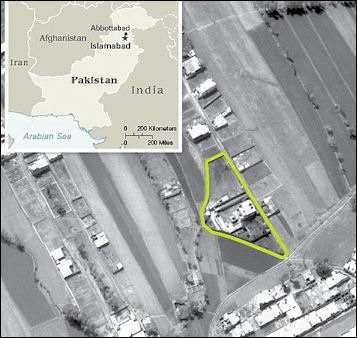
aerial view of Abbottabad compound It turned out that Osama bin Laden was in the Pakistani hill station town of Abbottabad. Bin Laden lived since 2005 in a three-story concrete house behind high-walls in an affluent neighborhood there. The compound was five kilometers from Pakistan’s equivalent of West Point and 60 kilometers north of Islamabad, Pakistan’s capital. Abbottabad is a popular summer resort, located in a valley surrounded by green hills near Pakistani Kashmir. Islamist militants, particularly those fighting in Indian-controlled Kashmir, used to have training camps near the town.
Patricia Zengerle and Alister Bull of Reuters wrote: “The building, about eight times the size of other nearby houses, sat on a large plot of land that was relatively secluded when it was built in 2005. When it was constructed, it was on the outskirts of Abbottabad's center, at the end of a dirt road, but some other homes have been built nearby in the six years since it went up, officials said. Intense security measures included 12- to 18-foot outer walls topped with barbed wire and internal walls that sectioned off different parts of the compound, officials said. Two security gates restricted access, and residents burned their trash, rather than leaving it for collection as did their neighbors, officials said. Few windows of the three-story home faced the outside of the compound, and a terrace had a seven-foot (2.1 meter) privacy wall, officials said. [Source: Patricia Zengerle and Alister Bull, Reuters, May 2, 2011]
In his book “Manhunt: The Ten-Year Search for Bin Laden” Peter L. Bergen wrote: “Whitewashed walls and large glass windows that looked out over the small, high-walled terrace kept things relatively bright in their bedroom. But the space was cramped for a man as tall as bin Laden.. The bedroom ceiling was low, no more than seven feet high. A tiny bathroom off to the side had green tile on the walls but none on the floor; a rudimentary toilet that was no more than a hole in the ground, over which they had to squat; and a cheap plastic shower. In this bathroom, bin Laden regularly applied Just for Men dye to his hair and beard to try to maintain a youthful appearance now that he was in his mid-fifties. Next to the bedroom was a kitchen the size of a large closet, and across the hall was bin Laden’s study, where he kept his books on crude wooden shelves and tapped away on his computer.” The compound had not telephone or Internet. It did have a satellite dish and seems plausible that bin Laden watched a lot television news. [Source: “Manhunt: The Ten-Year Search for Bin Laden — from 9/11 to Abbottabad” by Peter L. Bergen (Crown, 2012).
Associated Press reported: “Construction of the three-story house began about 2004, locals said. People initially were curious about the heavily fortified compound but over time they just grew to believe the family inside was deeply religious and conservative. The house has been described as a mansion, even a luxury one, but from the outside it is nothing special. Bin Laden may have well have been able to take in a view of the hills from secluded spots in the garden, though. The walls are stained with mold, trees are in the garden. [Source: Nahal Toosi and Zarar Khan, Associated Press, May 3, 2011]
People Inside Osama bin Laden’s Pakistan Compound and the Compound’s Value
Steve Coll wrote in The New Yorker: “The compound in Abbottabad was a crowded place, with 28 residents — including the 54-year-old bin Laden, his wives, eight of his children and five of his grandchildren, according to Brig. Shaukat Qadir, a retired Pakistani army officer who spent months researching the bin Laden raid and said he was given access to interrogation transcripts.The bin Laden children ranged in age from his son Khaled, who was in his 20s and was killed in the raid, to a 3-year-old born during their time in Abbottabad, said Qadir. Bin Laden's courier, the courier's brother and their wives and children also lived in the compound. Al-Sada, said to be bin Laden's favorite wife, was shot and wounded in the leg during the raid. [Source: Steve Coll, The New Yorker May 2, 2011]
The compound that Osama bin Laden lived was in the name of Arshad Khan. His cousin also lived there, The cousins, who are both forty-one at the time of the raid, regularly put in eleven-hour days, neighbors said. "That's longer than any man could stand to be next to his-wife!" one of the them told The New Yorker.
Nahal Toosi and Zarar Khan wrote in Associated Press: “Neighbors said they knew little about those inside in the compound but bin Laden apparently depended on two men who would routinely emerge to run errands or to a neighborhood gathering, such as a funeral. There were conflicting details about the men's identities. Several people said they were known as Tariq and Arshad Khan and had identified themselves as cousins from elsewhere in northwestern Pakistan. Others gave different names and believed they were brothers. Arshad was the oldest, and both spoke multiple languages, including Pashto and Urdu, which are common here, residents said. "It is also noteworthy that the property is valued at approximately $1 million but has no telephone or Internet service connected to it," an administration official said. "The brothers had no explainable source of wealth." [Source: Nahal Toosi and Zarar Khan, Associated Press, May 3, 2011]
U.S. analysts realized that a third family lived there in addition to the two brothers, and the age and makeup of the third family matched those of the relatives — including his youngest wife — they believed would be living with bin Laden. "Everything we saw, the extremely elaborate operational security, the brothers' background and their behavior and the location of the compound itself was perfectly consistent with what our experts expected bin Laden's hide-out to look like," another Obama administration official said.
Value of Osama bin Laden’s Pakistan Compound
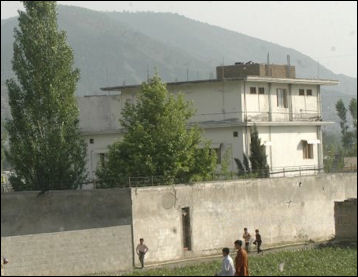
Osama bin Laden compound Local people, Eliza Griswold wrote in The New Yorker, “dismissed reports that described bin Laden's compound as a palace. "No way that cost one million dollars," Sardar, a neighbor, said... "Let's add up the numbers." Sardar said. Ahmad. A local real estate agent, got out a calculator. First, the land. The plot spans about six and a half kanals, which is around thirty-six thousand square feet. "I'm no good with figures," Sardar said. [Source:Eliza Griswold, The New Yorker , May 16, 2011]
“The compound's neighborhood, called Bilal Town, isn't prepossessing. Open sewers line the dusty lanes, and services, such as water, gas, and shopping, are lacking. Ahmad estimated the land to be worth roughly two hundred and thirty-seven thousand dollars. A few hours later, a visit to the town's land-revenue office... yielded more information: Arshad Khan, the man who had been sheltering bin Laden, had paid the equivalent of about sixty-six thousand dollars for the land, which he bought in three parcels, in 2004 and 2005. One of the plots had been purchased from a doctor named Qazi Mehfooz ul Haq. When Haq was reached at his clinic, he reluctantly said, "Yes, I sold it to Arshad," adding that Arshad had approached him several times about buying the land "for his uncle." Haq finally agreed to sell, making a profit of almost twelve thousand dollars.
"He was a very ordinary man," Haq said, of Arshad. "He had a little beard, like that man there." He pointed to a local with a bushy goatee. "He just very simply gave me a good offer." Haq said that he was tired of the chaos that had descended. Terrorism, the Taliban - these were issues for the governments to handle. "A typical man is worried about his daily living," he said. 'What difference does it make to him if it is Osama bin Laden or not?"
Back in the real-estate office, where Ahmad was still working on his calculation, discussion turned to a joke going around town-that Abbottabad should change its name to Osamabad. Ahmad said that building costs ranged from nine dollars a square foot, for an average house, to fourteen dollars a square foot, for a high-quality structure. He figured that building bin Laden's house would have cost, at the most, forty-one thousand dollars. So, allowing for appreciation of the amount paid for the land, Ahmad and Sardar estimated the compound's value at under three hundred thousand dollars.
“The statement that John Brennan, the President's top counterterrorism adviser, made about the house-"Here is bin Laden, who has been calling for these attacks, living in this milliondollar-plus compound"-seemed intended to shame the dead man. Ahmad and Sardar found it funny that the United States was portraying the house as opulent."Osama was living here in this bullshit compound inside a military base with a TV from 1994!" Ahmad said. The cousins had seen the television set in news footage. Sardar didn't care about such characterizations. "We need light, water, health, education," he said. ''Not visas to America and war equipment." That day, there had been power for only two hours of the workday, and a small generator whirred in the corner.
Life in Osama bin Laden’s Pakistan Compound
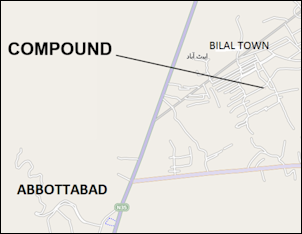 Associated Press reported: “Although the house is large, it was unclear how three dozen people could have lived there with any degree of comfort.” One of bin Laden’s wives, identified as Yemeni-born Amal Ahmed Abdullfattah, told interrogators she had been staying in bin Laden’s hideout since 2006 and never left the upper floors of the large but sparsely furnished building, said a Pakistani intelligence official. [Source: AP, May 7, 2011]
Associated Press reported: “Although the house is large, it was unclear how three dozen people could have lived there with any degree of comfort.” One of bin Laden’s wives, identified as Yemeni-born Amal Ahmed Abdullfattah, told interrogators she had been staying in bin Laden’s hideout since 2006 and never left the upper floors of the large but sparsely furnished building, said a Pakistani intelligence official. [Source: AP, May 7, 2011]
Munir Ahmed of Associated Press wrote: “Bin Laden spent his last weeks in a house divided, amid wives riven by suspicions. On the top floor, sharing his bedroom, was his youngest wife and favorite. The trouble came when his eldest wife showed up and moved into the bedroom on the floor below.” [Source: Munir Ahmed, Associated Press, April 13, 2012]
Dina Temple-Raston wrote in the Washington Post: “Contrary to gossipy news reports, there was harmony in the household. Bin Laden’s three wives accepted polygamy and believed, as he did, that the arrangement was sanctioned by God.
Steve Coll wrote in The New Yorker: Bin Laden “had always lived surrounded by family and children, so it is not surprising that he had managed to do so even as a fugitive... Bin Laden’s Syrian and Saudi wives were said to have gone home before or immediately after the September 11th attacks, and the Saudi wives were said to be living in the kingdom, without contact with Osama. When I visited Yemen in 2007, to conduct research on the bin Laden family, Yemeni journalists told me that his youngest wife had returned home and was living in the region either of Tai’zz or of Ibb, significant cities to the south of Sanaa, the capital. It seems that she may have found her way to Pakistan to live with her husband. My own guess had been that bin Laden would have accepted informal divorce from his older wives on the ground of involuntary separation, and would have remarried a local woman or two while in hiding in Pakistan, perhaps a daughter presented by one of his Pathan hosts. That is at least conceivable as well. Apparently, one of his adult sons was killed in the raid. Osama has more than a dozen sons. Some have returned to Saudi Arabia, but others have appeared in videos with their father, vowing to fight alongside him. It is conceivable that one of his sons could make a claim on Al Qaeda leadership in the years ahead.
To ensure that tranquility reigned, Bergen wrote “bin Laden created a dedicated living space for each wife in all his homes. On the Abbottabad compound, each wife had her own separate apartment with its own kitchen.” This domestic arrangement was a source of genuine solace for bin Laden, Bergen reports. So much so that he allegedly used to joke to his friends: “I don’t understand why people take only one wife. If you take four wives you live like a groom.” Bergen writes that this is the only recorded joke bin Laden ever made. [Source:Dina Temple-Raston, Washington Post, May 4, 2011]
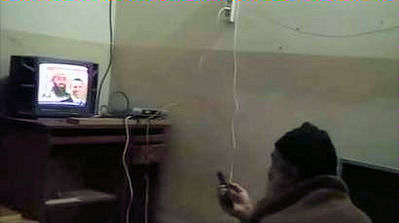
Osama bin Laden
watching himself on TV
Greg Miller wrote in the Washington Post: “Current and former U.S. intelligence officials said bin Laden employed remarkable discipline in his efforts to evade detection. “You’ve got to give him credit for his tradecraft,” said a former senior CIA official who played a leading role in the manhunt. When spotted by surveillance drones a decade earlier, bin Laden “had bodyguards, multiple SUVs and things like that. He abandoned all of that.” [Source: Greg Miller, Washington Post , May 17, 2011]
Others think maybe bin Laden got too overconfident. “Bin Laden got lazy and complacent,” a senior U.S. official told the Washington Post. “I don’t think he thought he would meet his maker in that house. And he certainly didn’t make any preparations to escape a raid or destroy the information found inside, the official said. [Source: Greg Miller and Karen DeYoung, Washington Post, May 12, 2011]
AP reported: “Those who live nearby said the people in bin Laden's compound rarely strayed outside. Most were unaware that foreigners — bin Laden and his family are Arabs — were living there. Khurshid Bibi, in her 70s, said one man living in the compound had given her a lift to the market in the rain. She said her grandchildren played with the kids in the house and that the adults there gave them rabbits as a gift. [Source: AP, May 3, 2011]
But the occupants also attracted criticism. "People were skeptical in this neighborhood about this place and these guys. They used to gossip, say they were smugglers or drug dealers. People would complain that even with such a big house they didn't invite the poor or distribute charity," said Mashood Khan, a 45-year-old farmer.
Porn Found in the Bin Laden Compound and Osama bin Laden Watching Himself on TV
AP reported: “From a shabby, makeshift office, the world's most wanted man watched newscasts of himself from a tiny television perched atop a rickety old desk cluttered with wires. A few days after his death the U.S. released a handful of videos, selected to show bin Laden in a much more candid, unflattering light. In the short clips, bin Laden appears hunched and tired, seated on the floor, watching television wrapped in a wool blanket and wearing a knit cap. Outtakes of his propaganda tapes show that they were heavily scripted affairs. He dyed and trimmed his beard for the cameras, then shot and reshot his remarks until the timing and lighting were just right. [Source: AP, May 7, 2011]
One video clearly shows the terror leader choosing and changing channels with a remote control, which he points at what appears to be a satellite cable box. U.S. officials have previously said there was a satellite dish for television reception but no Internet or phone lines ran to the house. Cellphones were prohibited on the compound.
A videos showing "out-takes" - the miscues by bin-Laden that were destined for the cutting room floor - were offered as further proof of bin Laden's death. But by selecting unflattering clips of bin Laden, the U.S. is also working to shatter the image he worked so hard to craft. "It showed that bin Laden was not the superhero he wanted his people to think," said Rep. Peter King, R-N.Y., the chairman of the House Homeland Security Committee.
AP and Fox News reported: “A stash of pornography was found in the Pakistani compound of Osama bin Laden. The pornography taken from the compound, first reported by Reuters, is said to have included modern, electronically recorded video and is described as fairly extensive. But officials told Reuters they did not know if the terror leader acquired the porn himself or even viewed it. It was unclear who it belonged to. Bin Laden’s son and two other adult males lived at the compound. [Source:AP, Fox News, May 13, 2011]
Bin Laden's Abbottabad compound did not have Internet connection or other hard-wired communication networks. But the compound was equipped with televisions after the U.S. government released videos taken from the raid showing the Al Qaeda leader watching himself on TV. The discovery of pornography taken during raids on Islamic militants is not uncommon, officials told Reuters.
Abbottabad
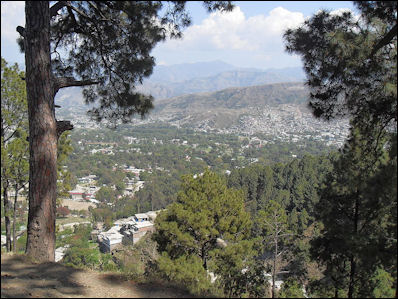
Abbottabad View AP reported: “Like many Pakistani towns where the army has a strong presence, Abbottabad is well-manicured, and has solid infrastructure. Street signs tell residents to "Love Pakistan." The city also is known for its good schools, including some that were originally established by Christian missionaries.”
Steve Coll wrote in The New Yorker: Abbottabad is essentially a military-cantonment city in Pakistan, in the hills to the north of the capital of Islamabad, in an area where much of the land is controlled or owned by the Pakistani Army and retired Army officers. Although the city is technically in what used to be called the Northwest Frontier Province, it lies on the far eastern side of the province and is as close to Pakistani-held Kashmir as it is to the border city of Peshawar. The city is most notable for housing the Pakistan Military Academy, the Pakistani Army’s premier training college, equivalent to West Point. Looking at maps and satellite photos on the Web last night, I saw the wide expanse of the Academy not far from where the million-dollar, heavily secured mansion where bin Laden lived was constructed in 2005. The maps I looked at had sections of land nearby marked off as “restricted areas,” indicating that they were under military control. It stretches credulity to think that a mansion of that scale could have been built and occupied by bin Laden for six years without its coming to the attention of anyone in the Pakistani Army. [Source: Steve Coll, The New Yorker May 2, 2011]
Abbottabad is also a transit point for militants moving between Kashmir and the tribal areas. The region is the prime recruitment base of militant groups such as Harakat-ul-Mujahedeen, whose training camps and other facilities still exist nearby in Mansehra. At least two other top al-Qaida leaders were sheltered in Abbottabad. Al-Qaida's No. 3, Abu Faraj al-Libi, lived in the town before his arrest in 2005 elsewhere in northwest Pakistan, according to U.S. and Pakistani officials. Earlier this year, Indonesian terror suspect Umar Patek was nabbed at a house in the town following the arrest of an al-Qaida courier who worked at the post office. It is not clear whether Patek had any links with bin Laden. [Source: Carlotta Gall, Pir Zubair Shah and Eric Schmitt, New York Times, June 23, 2011]
Why Did Osama bin Laden Choose Abbottabad?
Nahal Toosi and Zarar Khan of Associated Press wrote: “Also unclear was why bin Laden chose Abbottabad.... The bustling streets are dotted with buildings left over from British colonial days. These days it attracts some tourists, but is known mostly as a garrison town wealthier than many others in Pakistan. Bin Laden found it safe enough to stay for up to six years, according to U.S. officials, a stunning length of time to remain in one place right under the noses of a U.S.-funded army that had ostensibly been trying to track him down. Most intelligence assessments believed him to be along the Afghan-Pakistan border, perhaps in a cave. [Source: Nahal Toosi and Zarar Khan, Associated Press, May 3, 2011]
Greg Miller wrote in the Washington Post: U.S. government officials “outlined emerging theories as to why bin Laden apparently selected the Pakistani military garrison city of Abbottabad as the place that afforded him the greatest chance to stay alive. The city, about two hours north of Islamabad by car, offered a number of advantages for the al-Qaeda leader, officials said. Chief among them is that Abbottabad, deep inside Pakistan’s borders, is a safe distance from the tribal regions that are patrolled by armed U.S. drones. [Source: Greg Miller, Washington Post , May 17, 2011]
U.S. officials said they are convinced that bin Laden, who had long immersed himself among the Pashtun tribes along the border with Afghanistan, was driven from that part of the country by the escalating drone campaign. “Even five years ago things were dropping from the sky” in Pakistan’s tribal region, a U.S. official said. “He probably felt that if he could conceal his presence [in Abbottabad] it would be an unlikely area for the United States to pursue him.”
Strikes by conventional U.S. aircraft would have carried enormous risks, both because Pakistan has invested heavily in air detection and defense systems — to counter any threat posed by India — and because of the perils of an errant strike. “All it has to be is about 1,000 yards off and it hits the Pakistan Military Academy,” said a CIA veteran of Afghanistan and Pakistan. The city is also home to two regimental compounds, and suburbs occupied by military families.

Osama bin Laden hideout
U.S. officials said there were also disadvantages for bin Laden in residing in Abbottabad, including the fact that the area is relatively welcoming to outsiders, including Pakistanis on vacation, military families being transferred to bases there and even U.S. soldiers who have at times been sent to Abbottabad to train Pakistani troops. “Abbottabad is not a place where Islamic extremists went, because it wasn’t a stronghold,” said the former U.S. intelligence official involved in the bin Laden pursuit. “They preferred places like Peshawar, Quetta or Karachi.” When analysts would consider likely locations for the al-Qaeda chief, the official said, “Abbottabad wouldn’t be on that list.”
Osama bin Laden Led Al-Qaida from His Pakistan Compound
AP reported: Evidence seized by Navy SEALs after the raid that killed bin Laden in his walled Pakistani compound reveal that bin Laden was still actively involved in planning and directing al-Qaida's plots against the U.S., according to a senior U.S. intelligence official. The notes and computer material showed that bin Laden's compound was a command and control center for al-Qaida, where the terrorist mastermind stayed in contact with al-Qaida affiliates around the world through a network of couriers, the intelligence official said. Bin Laden was eager to strike American cities again and discussed ways to attack trains, officials said, though it appeared that plan never progressed beyond early discussions. [Source: AP, May 7, 2011]
Osama bin Laden “was in touch with key members of al Qaeda, playing a strong role in planning and directing attacks by al Qaeda and its affiliates in Yemen and Somalia, senior US officials said citing documents found during the raid in which bin Laden was killed. It shows that bin Laden was a lot more involved in directing al Qaeda personnel and operations than sometimes thought over the last decade, officials said. And it suggests bin Laden was “giving strategic direction” to al Qaeda affiliates in Somalia and Yemen, one defense official said.
U.S, counterterrorism officials have long debated how big a role bin Laden and core al Qaeda leaders were playing in the attacks launched by affiliated terror groups, particularly al Qaeda in the Arabian Peninsula, which is based in Yemen, and al-Shabab in Somalia. Bin Laden’s first priority, an official said, was his own security. But the data shows that he was far more active in providing guidance and telling affiliated groups in Yemen and Somalia what they should or should not be doing.
Based on documents found in Osama bin Laden’s compound, David Ignatius wrote in the Washington Post: It’s clear bin Laden “was paranoid about being found and killed: He ordered his subordinates to restrict movements to help preserve what remained of al-Qaeda in Pakistan. Fear of being discovered was a subject of regular conversation between bin Laden, Atiyah, Zawahiri and others.” [Source: David Ignatius, Washington Post, August 23, 2011]
Pakistan Says Osama bin Laden was Weak and Marginalized in His Final Days
AP reported: Pakistan’s military paints a different picture than the United States of Osama bin Laden’s final days: far from the terror mastermind still trying to strike America, he’s seen as an aging terrorist hiding in barren rooms, short of money and struggling to maintain his grip on al Qaeda. [Source: AP, May 7, 2011]
Pakistani officials told AP that disputes over money between bin Laden and his No. 2, Ayman al-Zawahri, led the group to split into two factions in 2005 or 2006, with the larger faction controlled by al-Zawahri. Bin Laden was “cash strapped” in his final days, they said.
A weak bin Laden would make Pakistan’s failure to unearth his hiding place in Abbottabad, a military town just two-and-a-half hours’ drive from the capital, seem less of a glaring embarrassment, while a menacing bin Laden would make the US Navy SEAL raid that killed him a greater triumph.
Image Sources: Wikimedia Commons
Text Sources: New York Times, Washington Post, Los Angeles Times, Times of London, The Guardian, National Geographic, The New Yorker, Time, Newsweek, Reuters, AP, AFP, Wall Street Journal, The Atlantic Monthly, The Economist, Global Viewpoint (Christian Science Monitor), Foreign Policy, Wikipedia, BBC, CNN, NBC News, Fox News and various books and other publications.
Last updated July 2012
Image Sources: Wikimedia Commons
Text Sources: New York Times, Washington Post, Los Angeles Times, Times of London, The Guardian, National Geographic, The New Yorker, Time, Newsweek, Reuters, AP, AFP, Wall Street Journal, The Atlantic Monthly, The Economist, Global Viewpoint (Christian Science Monitor), Foreign Policy, Wikipedia, BBC, CNN, NBC News, Fox News and various books and other publications.
Last updated July 2012
